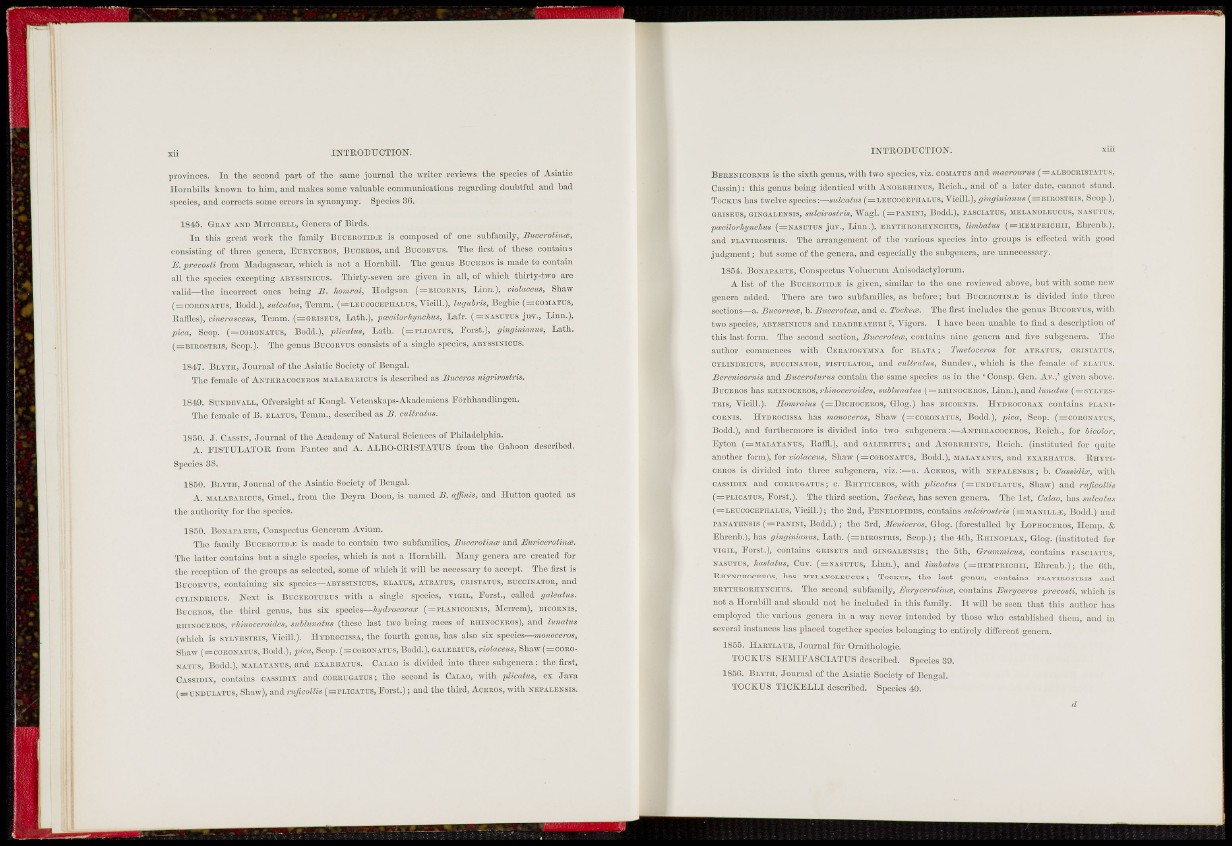
xii INTRODUCTION.
provmccs. In the second part of the same journal the -writer reviews the species of Asiatic
Jlornbills known to him, and makes some valuable communications regarding doubtful and bad
spccics, and corrects some errors in synonymy. Species 3G.
ISdiS. OKAY AND MiTcnELL, Genera of Birds.
I n this great work the family BUCEROTID^ is composed of one subfamily, BuoerotincB,
consisting of three genera, ExjurcEROS, BUCEROS, and Buoouvus. The first of these contains
i ' . prevoati from Madagascar, which is not a Ilornbill. The genus BUCEUOS is made to contain
all the spccics excepting ABYSSINICUS. Thirty-seven are given in all, of which thirty-two are
valid—the incorrect ones being B. liomrai, Hodgson (=BicoiiNrs, Lum.), tiolaceus, Shaw
(=C0R0NATUS, Bodd.), sidcatus, Temm. (=LEI-COCEPHALUS, Vieill.), lugtihris, Begbic (=COIIATI;S,
Ilaiiles), cinerascens, Temm. (=GUISEUS, Lath.), pcecilorhi/uchus, La£r. (=NASUTUS juv.. Linn.),
pica. Scop. (-COILONATUS, Bodd.), pUcatm, Lath, (=PLICAI-[IS, Eorst.), ginginianus. Lath.
(=:i5iR0STiiis, Scop.). The genus BUCORVUS consists of a single species, ABYSSI>'ictJS.
1847. BLYM, Journal of the Asiatic Society of Bengal.
The female of ANTIIRACOCEROS MAXABARICUS is described as JBiiceros nigrirostris.
1849. SUNDEVALL, Ofversight af Jvongl. Vetenskaps-Akade miens Porhliandlingen.
The female of B. ELATUS, Temm., described as B. cuUratus.
1850. J. CASSIN, Journal of the Academy of Natural Sciences of Philadelphia.
A. PISTULATOR from Pantee and A. ALBO-CRISTATUS from the Gaboon described.
Species 38.
1850. BLYTH, Journal of the Asiatic Society of Bengal.
A. jtALABARicus, GmcL, from the Deyra Doon, is named B. qffinis, and Hutton quoted as
the authority for the species.
1850. BoNArARTE, Conspectus Generum Avium.
The family BucEROxiDiE is made to contain two subfamilies, BuceroUnce and HuricerotincB.
The latter contains but a single species, wliich is not a Ilornbill. Many genera are created for
the reception of the groups as selected, some of which it will be necessary to accept. The iirst is
BucoRvrs, containing sis species—ABYSSINICUS, ELATUS, ATRATUS, CRISTATUS, BUCCINATOR, and
CYLiXDRicrs. Next is BUCEROTURUS with a single species, VIGIL, Forst., called galeatus.
BL-CEROS, the third genus, has six spccics-A^I^ROCORC^R (=PLANICORNIS, Merrem), BicoRifis,
RIIINOCEROS, rUnoceroides, siibhmaUis (these last two being races of RniNOCEROs), and limatus
(which is SYLVESTRIS, Vicill.). IIYDROCISSA, the fourth genus, has also six species—MOIIOCEROS,
GJJJI^Y (=CORONATUS, Bodd.), pica, Scop. (=C0R0NATUS, Bodd.), GALERITUS, violaceus, Shaw (=CORONAITS,
Bodd.), MALAYA:^^•cs, and EXARHATUS. CALAO is divided into three subgenera; the first,
CASSIDIX, contains CASSIDIX and CORRTTGATUS; the second is CALAO, with •plicatus, ex Java
(=U>-DTJLATUS, Shaw), and ruficollis (=I>LICATUS, Forst.); and the third, ACEROS, with LIEPIIENSIS.
INTEODUCTION. xiii
BEEENICORNIS is the sixth genus, with two species, viz. COMATITS and macroiirus (=ALBOCRISTATUS,
Cassia): this genus being identical with ANORREIXUS, Reich., and of a later date, cannot stand.
TOCKUS has twelve species:—SWZCATES (=LEUCOCEPNALUS, VieilL), ginginianus (=BIROSTRI.S. Scop.),
GRISEUS, GINGALENSIS, sulcirostris, "VVagl. (=PANI:III, Bodd.), FASCIATUS, MELANOLEUCUS, NASUTUS,
pcecilorhjnchus (=NASUTUS juv.. Linn.), ERYTiiRORHYNCnus, linibatus ( = HEiiPRiciiii, Ehrcnb.),
and FLAVIROSTRIS. The arrangement of the various species into groups is eiTccted with good
judgment; but some of the genera, and especially the subgenera, arc unnecessary.
1854. BONAPARTE, Conspectus Volucrum Anisodactylorum.
A list of the BucERoTiDiE is given, similar to the one reviewed above, but with some now
genera added. There are two subfamilies, as before; but BUCEROTIN^ is divided into three
sections—a. Bucorvem, b. Buceroteai, and c. Tockecc. The first includes tlic genus BUCORVUS, with
two species, ABYSSINICTJS and LEADBBATERI ?, Vigors. I have been unable to iind a description of
this last form. The second section, Bucerotece, contains nine genera and five subgenera. Tlie
author commences witli CERATOGYJINA for ELATA; Tmetoceros for ATRATUS, CRISI'ATUS,
GYLINDRICUS, BUCCINATOR, FISTITLATOR, and cuUratus, Sundcv., which is the female of BLATUS.
Berenicornis and BxiCcroUirus contain the same species as in the ' Consp. Gen. Av.,' given above.
BUCEROS has RHINOCEROS, RAIWOCCROIC^ÖS, stibhinatus ( = RUINOCEROS. Linn.), and lunatus (=SYLVESTRis,
VieiU.). Homraius (=DICIIOCEROS, Glog.) has BICORNIS. URNROCORAX contains PLANIcORNis.
IIYDROCISSA has monoceros, Shaw {=CORONATUS, Bodd.), pica, Scop. (=CORONATUS,
Bodd.), and furthermore is divided into two subgenera:—ANTURACOCEROS, Reich., for hicolor,
Eyton (=MALAYANUS, Raffl.), and GALERITUS; and ANOIUUIINUS, Rcich. (instituted for quite
another form), for violaceus, Shaw (=CORONATUS, Bodd.), MALAYANUS, and EXARIIATUS. RDYTICEROS
is divided into three subgenera, viz.:—a. ACBROS, with NEPALENSIS; b. Cassidix, with
CASSIDIX and CORRUGATUS; C. RHYTICEROS, with plicatm (=UNDDLATUS, Shaw) and ruficollis
(=PLICATUS, Porst.). The third section, TockecB, has seven genera. The 1st, Calao, has sulccituti
(=LEUC0CEPIIALUS, Vieill.); thc 2nd, PENELOPIDES, contains sulcirostris (=IIANILL/E, Bodd.) and
PAKAYENSIS (=PANiNi, Bodd.); the 3rd, Meniceros, Glog. (forestalled by LOPUOCEROS, Hemp. &
Ehrenb.), has ginginianus. Lath. (=BIROSTRIS. Scop.); the 4th, RIIINOPLAX, Glog. (instituted for
VIGIL, Porst.), contains GRISEUS and GINGALENSIS; the 5th, Grammicus, contains FASCIATUS,
NASUTUS, hastatus, Cuv. ( = NASUTUS, Linn.), and limhatus ( = IIBMI'Ricnii, Ehrcnb.); thc Gth,
RHYNCNOCEROS, has MELANOLEUCUS; TocKUS, the last genus, contains FLAVIROSTRIS and
ERYTHRORiiYNcnus. The second subfamily, Euryccrotino}, contains Euryceros prevosti, which is
not a Hornbill and should not be included in this family. It will bo seen that this author has
employed the various genera in a way never intended by those who established thctn, and in
several instances has placed together species belonging to entirely different genera.
1855. HARTLAUB, Jom-nal für Ornithologie.
TOCKUS SEMIPASCIATUS described. Species 39.
1856. BLYTH, Journal of the Asiatic Society of Bengal.
TOCKUS TICKELLI described. Species 40.
d